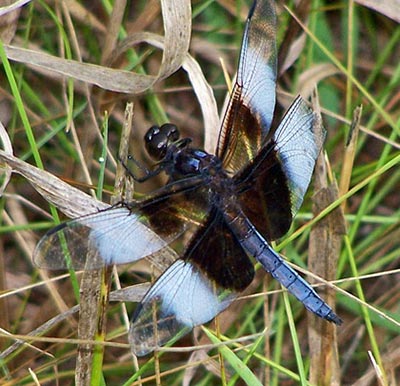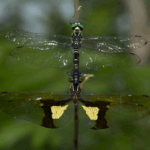The black and blue dragonfly is a stunning creature that captivates nature enthusiasts and casual observers alike. With its vibrant colors and graceful movements, it stands out in the world of insects. This article explores the beauty, behavior, and ecological significance of the black and blue dragonfly, highlighting why it is considered a masterpiece of nature.
The Appearance of the Black and Blue Dragonfly
The black and blue dragonfly is easily recognizable due to its striking coloration. Its body features a combination of deep black and bright blue hues, creating a visually appealing contrast. The wings are transparent and delicately veined, allowing sunlight to filter through and enhance the dragonfly’s vibrant colors.These dragonflies typically measure between two to four inches in length, with a wingspan that can reach up to six inches. Their large, multifaceted eyes provide excellent vision, enabling them to spot potential prey and predators from a distance. The combination of their physical attributes makes them one of the most beautiful insects in the world.

Habitat and Distribution
Black and blue dragonflies can be found in various habitats, including wetlands, ponds, lakes, and slow-moving streams. They thrive in areas with abundant vegetation, which provides shelter and hunting grounds. These dragonflies are distributed across many regions, particularly in temperate and tropical climates.During the warmer months, they are often seen darting above water surfaces, where they hunt for smaller insects. Their presence is a good indicator of a healthy ecosystem, as they require clean water and a balanced environment to thrive.
Behavior and Hunting Techniques
The black and blue dragonfly is known for its agile flight and impressive hunting skills. They are predatory insects, primarily feeding on smaller flying insects such as mosquitoes, flies, and midges. Their hunting technique involves a combination of speed and precision.When hunting, these dragonflies can reach speeds of up to 30 miles per hour. They use their keen eyesight to track prey and can change direction swiftly to catch it mid-air. This ability to maneuver quickly makes them formidable hunters in their habitat.
Reproduction and Life Cycle
The life cycle of the black and blue dragonfly consists of several stages: egg, larva (nymph), and adult. The female dragonfly lays her eggs in or near water, where they will hatch into larvae. Dragonfly larvae, also known as nymphs, are aquatic and can live for several months to a few years, depending on the species and environmental conditions.During this time, nymphs undergo multiple molts as they grow. They are also predators in their own right, feeding on small aquatic organisms. Once they reach maturity, they emerge from the water, shed their exoskeleton, and transform into adult dragonflies.The adult stage is relatively short-lived, lasting only a few weeks to a few months. During this time, their primary focus is on reproduction. Males often engage in territorial displays to attract females, showcasing their vibrant colors and agile flight.
Ecological Importance
The black and blue dragonfly plays a crucial role in the ecosystem. As both predators and prey, they contribute to the balance of their environment. By controlling insect populations, they help maintain a healthy ecosystem. Additionally, their presence indicates good water quality and biodiversity.Dragonflies are also an essential food source for various birds, fish, and other wildlife. Their life cycle and behavior demonstrate the interconnectedness of nature, highlighting the importance of preserving their habitats.
Conservation Status
While the black and blue dragonfly is not currently considered endangered, habitat loss and pollution pose significant threats to their populations. Wetland destruction and water quality degradation can lead to declines in dragonfly numbers. Conservation efforts aimed at protecting aquatic habitats are vital for ensuring the survival of this beautiful species.Public awareness and education about the importance of dragonflies and their habitats can help foster a greater appreciation for these remarkable insects. By promoting conservation initiatives, we can contribute to the protection of the black and blue dragonfly and the ecosystems they inhabit.
Legends of the Black and Blue DragonflyThe black and blue dragonfly is not only a remarkable insect due to its striking appearance but also a creature steeped in myth and folklore. Across various cultures, this dragonfly has inspired stories that reflect the beauty and mystery of nature. In this article, we will explore some of the legends associated with the black and blue dragonfly, examining how these tales have shaped our understanding of this fascinating insect.
Cultural Significance
In many cultures, dragonflies symbolize transformation and change. Their life cycle, which includes a metamorphosis from aquatic nymph to aerial adult, embodies the idea of growth and renewal. The black and blue dragonfly, with its vivid colors, often represents strength, courage, and adaptability.In Native American traditions, dragonflies are seen as messengers of change. They are believed to carry messages from the spirit world, guiding individuals through difficult times. The black and blue dragonfly, in particular, is associated with clarity and insight, encouraging people to embrace their true selves and pursue their dreams.
Folklore and Myths
Throughout history, the black and blue dragonfly has inspired numerous myths and legends. In some cultures, it is believed that these dragonflies possess magical powers. For example, in certain African folklore, dragonflies are thought to be the spirits of ancestors, watching over the living and guiding them through life’s challenges.In Japan, dragonflies hold a special place in the hearts of many. They are symbols of courage and strength, often depicted in art and poetry. The black and blue dragonfly is particularly revered, as it is believed to bring good fortune and prosperity. Japanese children often catch dragonflies and release them, believing that this act will bring them luck.
Symbolism in Literature
The black and blue dragonfly has also made its mark in literature. Many authors have used this insect as a symbol of transformation and resilience. In various poems and stories, the dragonfly represents the beauty of change and the importance of embracing one’s true nature.One notable example is in the works of the famous poet William Butler Yeats, who often used nature as a metaphor for human emotions and experiences. The dragonfly, with its delicate wings and vibrant colors, serves as a reminder of the fleeting nature of life and the beauty that can be found in moments of change.
The Dragonfly as a Spirit Guide
In some spiritual practices, the black and blue dragonfly is regarded as a spirit guide. It is believed that encountering this dragonfly can signal a time of personal growth and transformation. Many people report feeling a sense of clarity and purpose after witnessing these magnificent creatures.The dragonfly’s ability to navigate both water and air symbolizes the balance between the emotional and intellectual aspects of life. Those who seek guidance from the black and blue dragonfly often find inspiration to pursue their passions and overcome obstacles.
Conservation and Preservation
As we explore the legends and cultural significance of the black and blue dragonfly, it is essential to consider the importance of conservation. These beautiful insects face threats from habitat loss, pollution, and climate change. Protecting their habitats is crucial for preserving the stories and traditions associated with them.Conservation efforts aimed at maintaining healthy ecosystems can help ensure that future generations will continue to appreciate the beauty and significance of the black and blue dragonfly. By fostering a sense of stewardship for our natural world, we can honor the legends that have been passed down through generations.
The black and blue dragonfly is more than just a beautiful insect; it is a symbol of transformation, resilience, and cultural significance. The legends surrounding this dragonfly reflect humanity’s deep connection to nature and the lessons we can learn from it. As we continue to explore and appreciate the stories associated with the black and blue dragonfly, we must also commit to protecting its habitat and ensuring its survival for future generations. By doing so, we honor the legacy of this remarkable creature and the rich tapestry of myths and legends that it inspires.
The black and blue dragonfly is truly a masterpiece of nature, showcasing the beauty and complexity of the natural world. Its striking appearance, remarkable hunting abilities, and ecological significance make it a fascinating subject for study and admiration. By understanding and appreciating these incredible insects, we can take steps to protect their habitats and ensure their survival for future generations.






